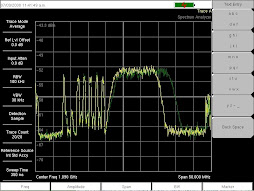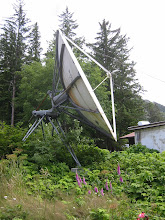Another successful test of Alaska's EAS on ARCS was carried out on Monday, November 2, 2009 at 1531 AST. The test in this recording was viewed at the APBI offices in Anchorage using a 3.0 meter Cband dish and a Scientific Atlanta D9223 receiver. The ARCS program service is part of a multiplex which includes several other video and audio sources. In the video you can see ARCS is in the upper left corner of the multi-monitor. Watch the colors as they fly through the air.
In the background audio you can hear a second set of tones and data bursts. That is coming from the Sage ENDEC at the other end of the room as it responded to the test.
Tuesday, November 3, 2009
Thursday, September 24, 2009
Sun Outages to Affect ARCSTV Services in October
Beginning Wednesday, October 7th, at approximately 12:50 P.M., all ARCS satellite dish antennas, as well as any dish aimed at SES Americom's AMC-8 spacecraft (aka: Aurora III) will experience brief interruptions in service known as "sun outages". They will happen between 12:50 and 1:10 P.M. daily through Tuesday, October 20th.
All services inside our multiplex on transponder 18 will be affected, including ARCS, Alaska One, UATV, and the associated audio channels. Also affected will be the SCPC radio channels on transponder 24.
These twice-yearly outages occur when the sun and the satellite we look at are aligned for a few minutes each day over the course of two weeks. They are not caused by sun spots.
If you would like to calculate more precise calculations for your particular location and dish size, visit the SES Americom site and use the Sun Outage Tool.
Questions? Comments? Use the comment link below.
All services inside our multiplex on transponder 18 will be affected, including ARCS, Alaska One, UATV, and the associated audio channels. Also affected will be the SCPC radio channels on transponder 24.
These twice-yearly outages occur when the sun and the satellite we look at are aligned for a few minutes each day over the course of two weeks. They are not caused by sun spots.
If you would like to calculate more precise calculations for your particular location and dish size, visit the SES Americom site and use the Sun Outage Tool.
Questions? Comments? Use the comment link below.
Labels:
alaska,
satellite,
sun outage,
television
Tuesday, September 22, 2009
Saint Paul Island Gets New Satellite Antenna
 The long running project to replace both the Radio SIP and ARCS satellite dishes in Saint Paul with a single shared use dish has come to completion. As of September 15th the new dish began serving both roles, providing KUHB Radio with feeds for APRN and other SCPC satellite channels, as well as providing the community with their ARCS television feed.
The long running project to replace both the Radio SIP and ARCS satellite dishes in Saint Paul with a single shared use dish has come to completion. As of September 15th the new dish began serving both roles, providing KUHB Radio with feeds for APRN and other SCPC satellite channels, as well as providing the community with their ARCS television feed.Planning for the project began two years ago when it became obvious to APBI and KUHB managers that both dishes were experiencing dropout and increasing rates of failure due to extreme corrosion brought about by the severe environment in which the dishes exist. Since both dishes look at the same satellite, and both ARCS and KUHB radio are located in the same building in Saint Paul, a partnership was proposed that would split the cost of replacement and share the use of the dish. Further savings were realized when the decision was made to use the existing ARCS dish gabion mount, which appeared to be in good condition.

ARCS used Denali Commission funding to purchase and transport the dish to Saint Paul Island. KUHB used a combination of Rasmusson Foundation Grant funds and its own sweat equity to finance and oversee the construction of the new dish which included bringing a contractor to the island to perform the installation work.
As a result, the community received a valuable communications tool that serves both the local public radio mission as well as the community’s ARCS television service, both of which also include Emergency Alert System notifications which run across both APRN and ARCS networks.
The old dishes can be seen in their final days when they were completely failing as satellite receive antennas.
Thursday, September 10, 2009
The Amber Alert Test ran across Alaska today. Here is a video shot live of the monitor in APBI's offices as the alert was received over the ARCS satellite channel. There are 6 video displays shown on the monitor; ARCS is the upper left hand display, where you can see the crawl across the top, and the audio present on the leftmost audio meters.
The ARCS display is fed with a DVB MPEG2 PowerVu satellite receiver connected to a 3.0 meter Cband satellite dish on our roof. The receiver is tuned to the multiplex on AMC8, transponder 18. The audio is mono, available on both left and right channels. We have a Sage EnDec in the office for monitoring purposes, which we keep it connected to a dedicated receiver locked to the ARCS channel. The L-1 audio is connected to the Sage audio input #1.
Below is an image of the tape generated from the test. You can see that it received and then sent out the complete message (note that this unit does is not connected to a broadcast station, it is only used for testing and observation). As you can see, ARCS carried the complete test from start to finish with no drop outs.
If your station experienced a problem, please check your connections, your EnDec filters and programming, the clock on your EnDec, and if all else fails, contact me and we can try to help resolve the issue.

Friday, June 12, 2009
Subscribe to:
Posts (Atom)
ARCS, Digital Television, and The Future
You have probably heard a lot about Digital Television and the upcoming February deadline when “all TV must be digital”. Well, not exactly. Even after February 2009, ARCS will still be “Analog” and your current TV will work just the same way it does now. You won’t need to make any changes to keep watching because ARCS is a “low-power” television system that is not required by the FCC to convert to digital at this time.
The FCC has required some 1,700 full-power stations nationwide to meet this conversion deadline. However there are nearly 7,000 low-power transmitters across the USA, just like ARCS, which are not yet required to convert. Most of these transmitters serve viewers in rural communities.
ARCS probably will convert to digital in the next three to five years, so eventually you will need to do something. One thing you can do right now is check out the TV Converter Box Coupon Program. Created by Congress, this program allows households to get up to two coupons, each worth $40, for use in obtaining a box that will convert over-the-air digital television signals for viewing on an analog television set. Even though you won’t need a converter to watch ARCS in the near term, you can still get your coupons, use them to purchase converters at the reduced cost, and then keep them for future use. You can find out more at http://www.dtv2009.gov/ or by calling toll free, 888-388-2009.
Meanwhile we continue to work with volunteers across the state, in more than 230 communities, to repair and maintain the ARCS system.
Would you like to help keep ARCS going in your community? Send an email to arcstv@gmail.com.




